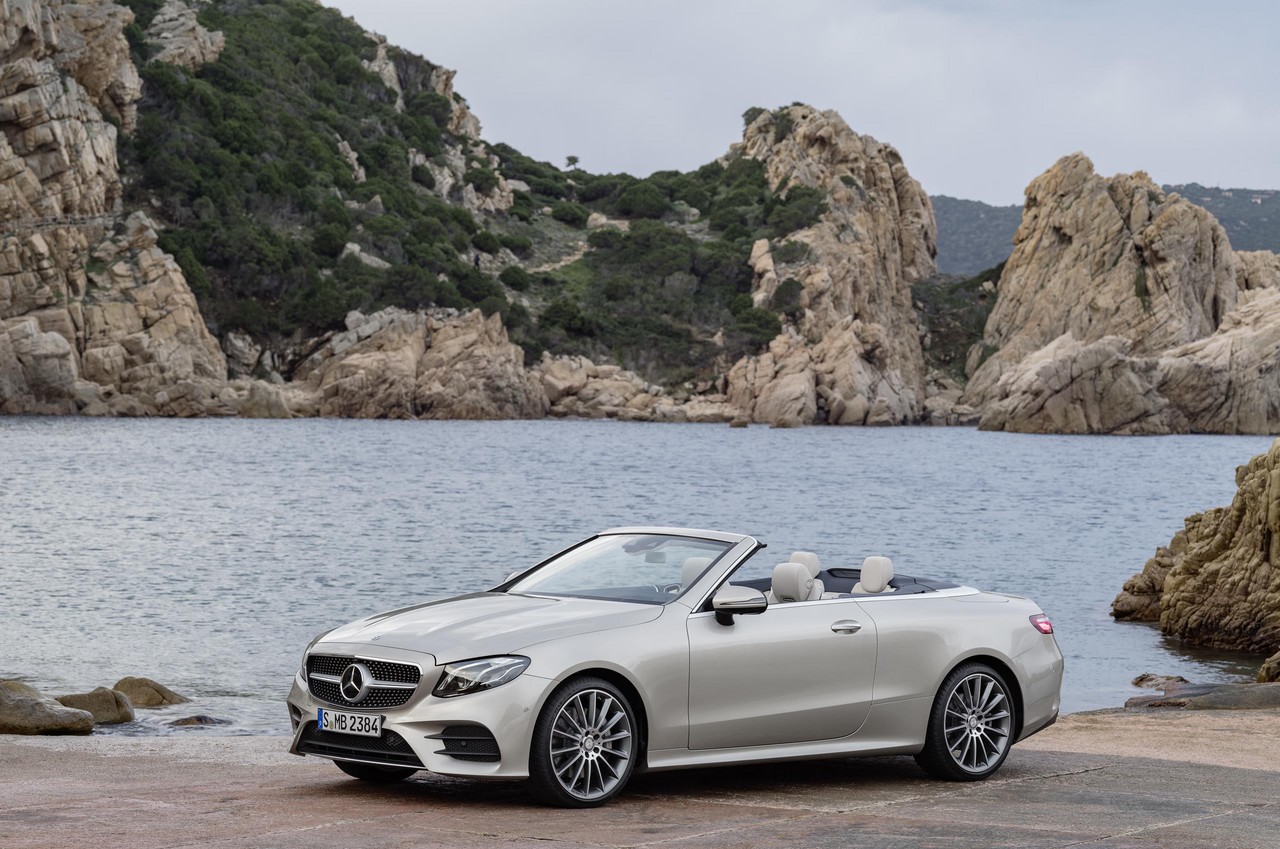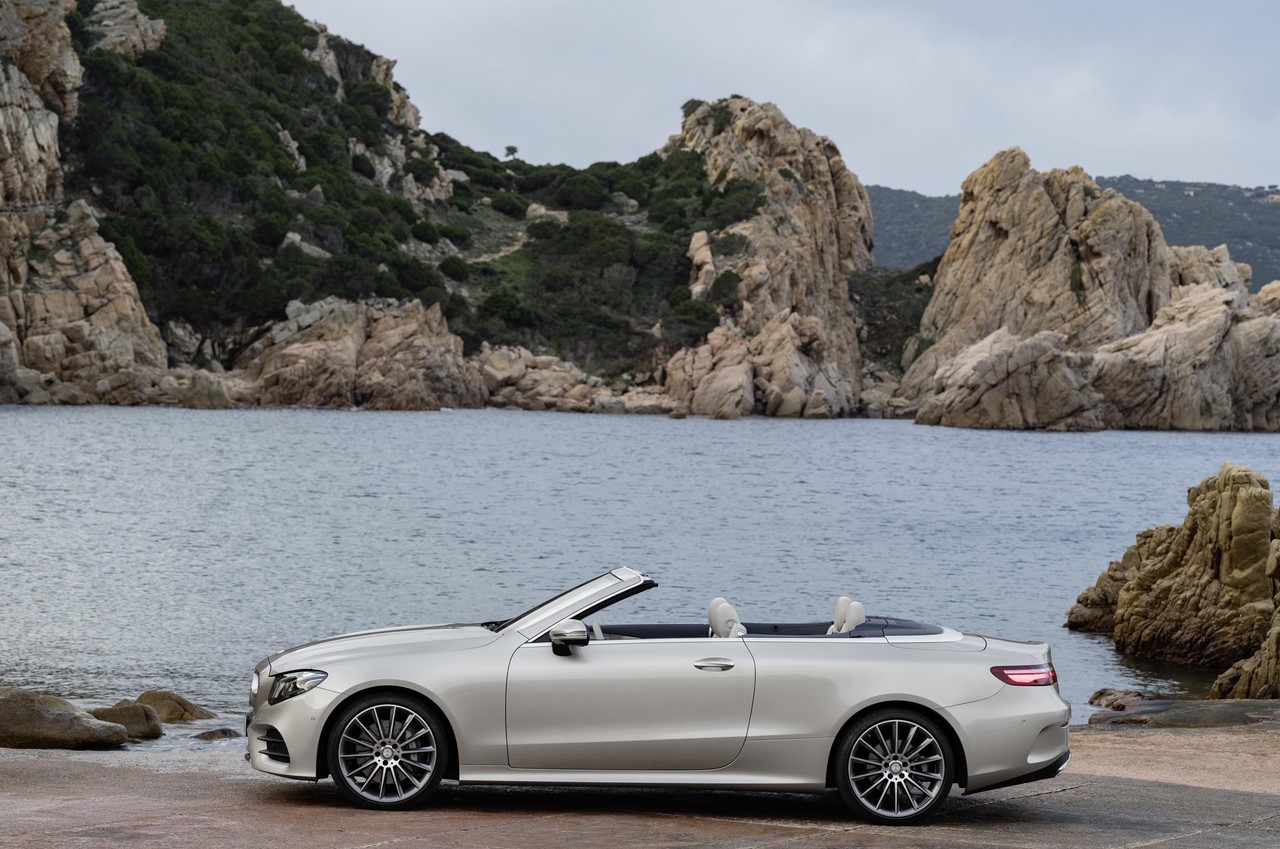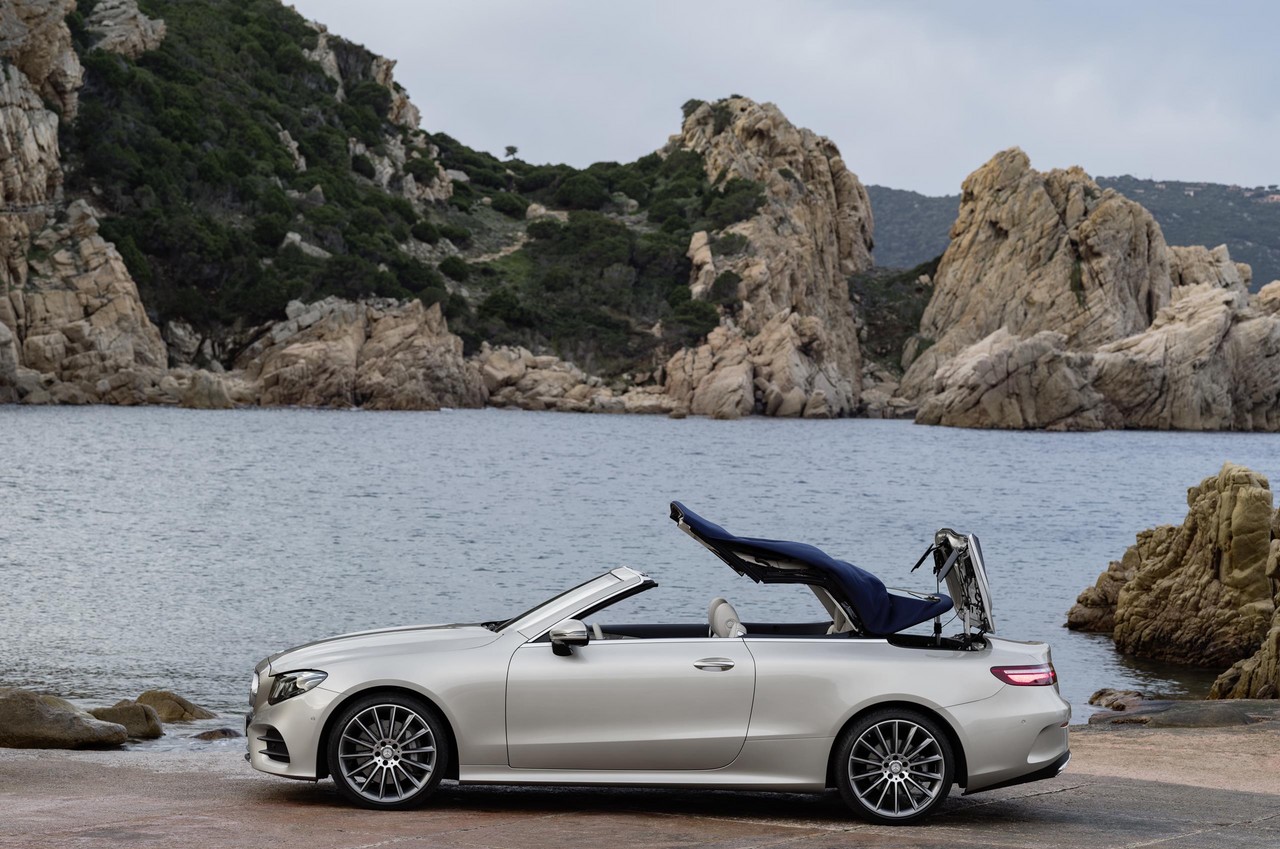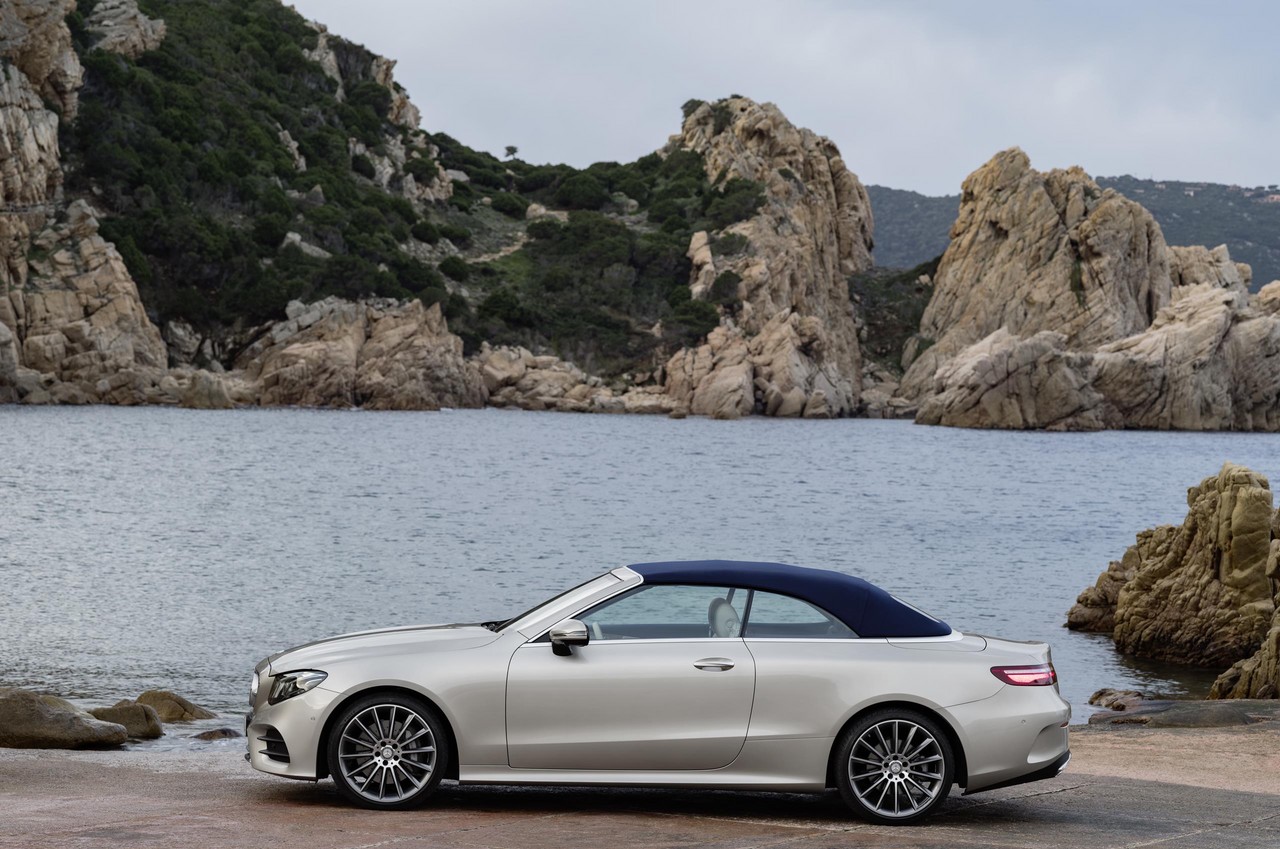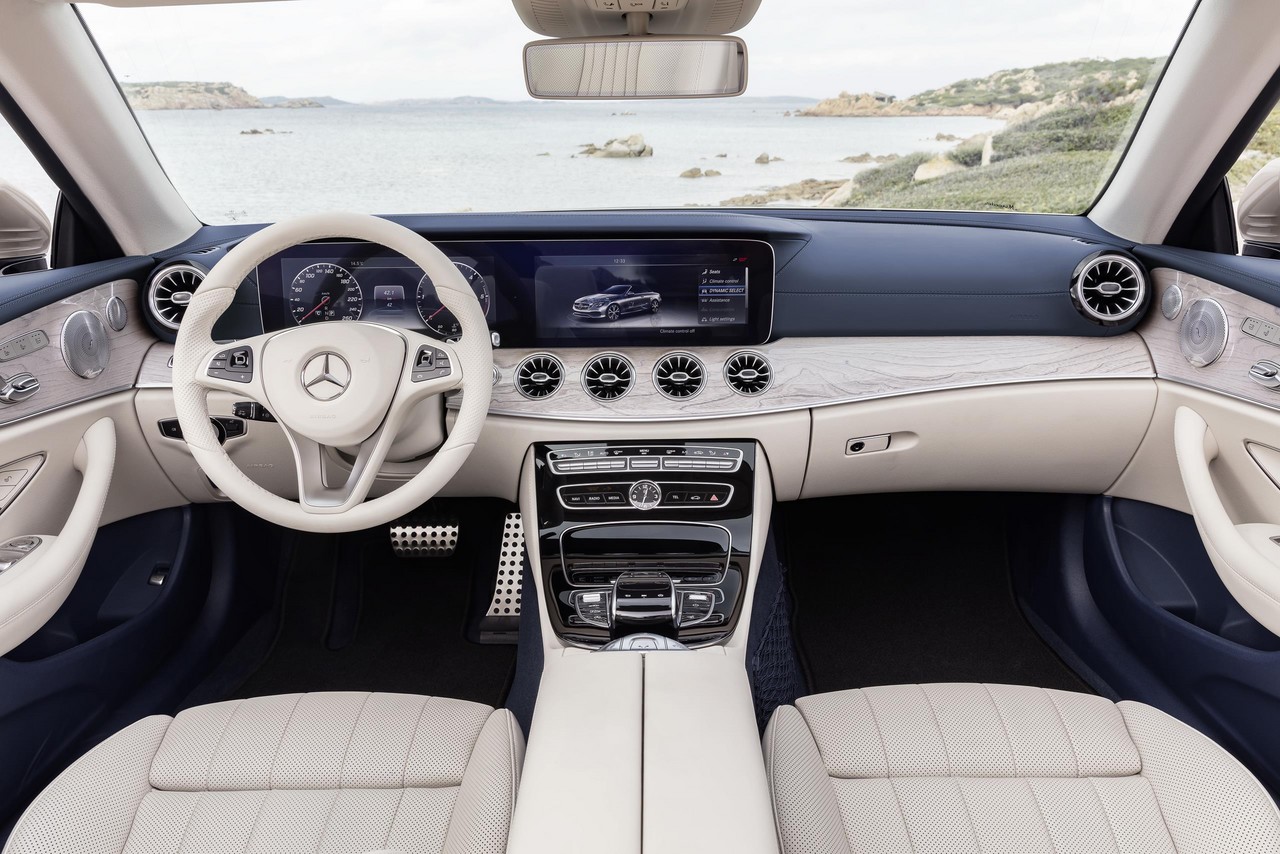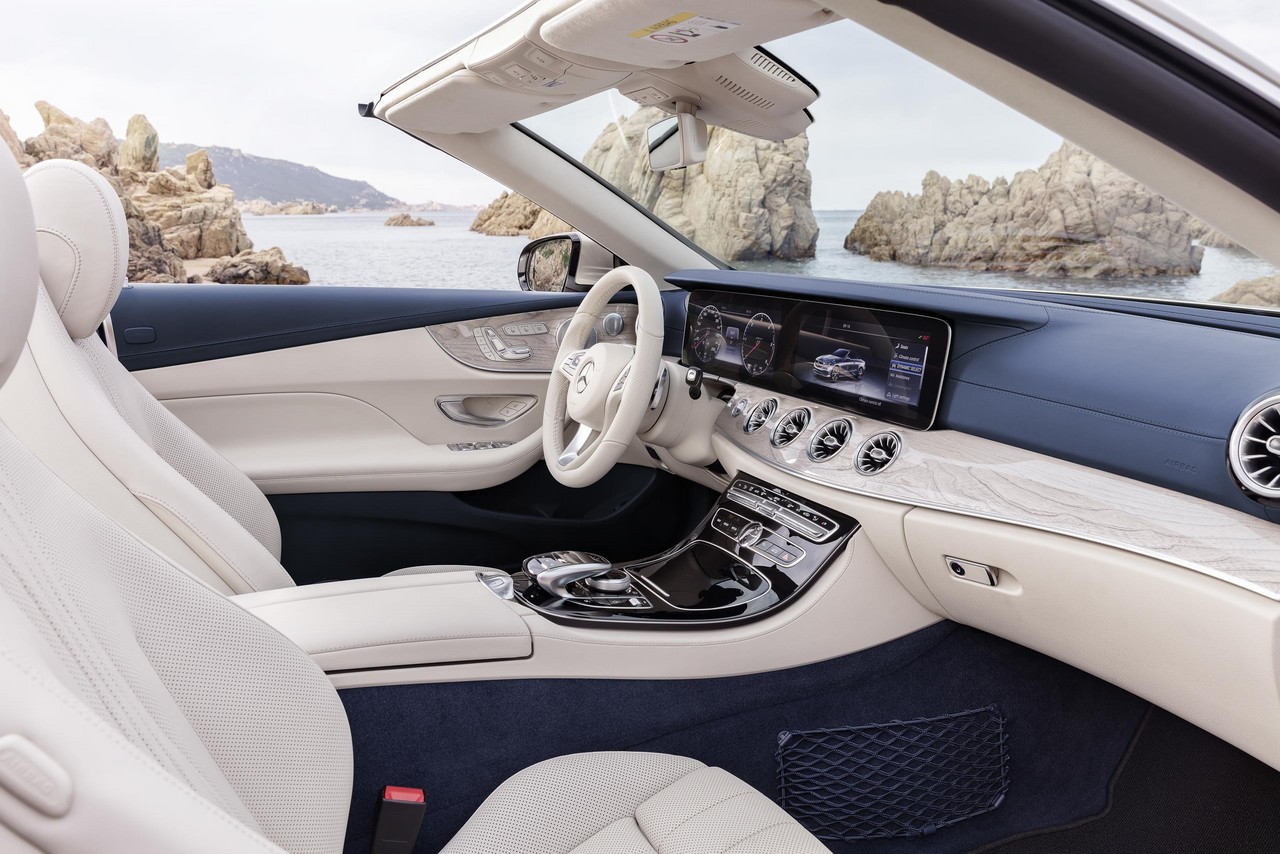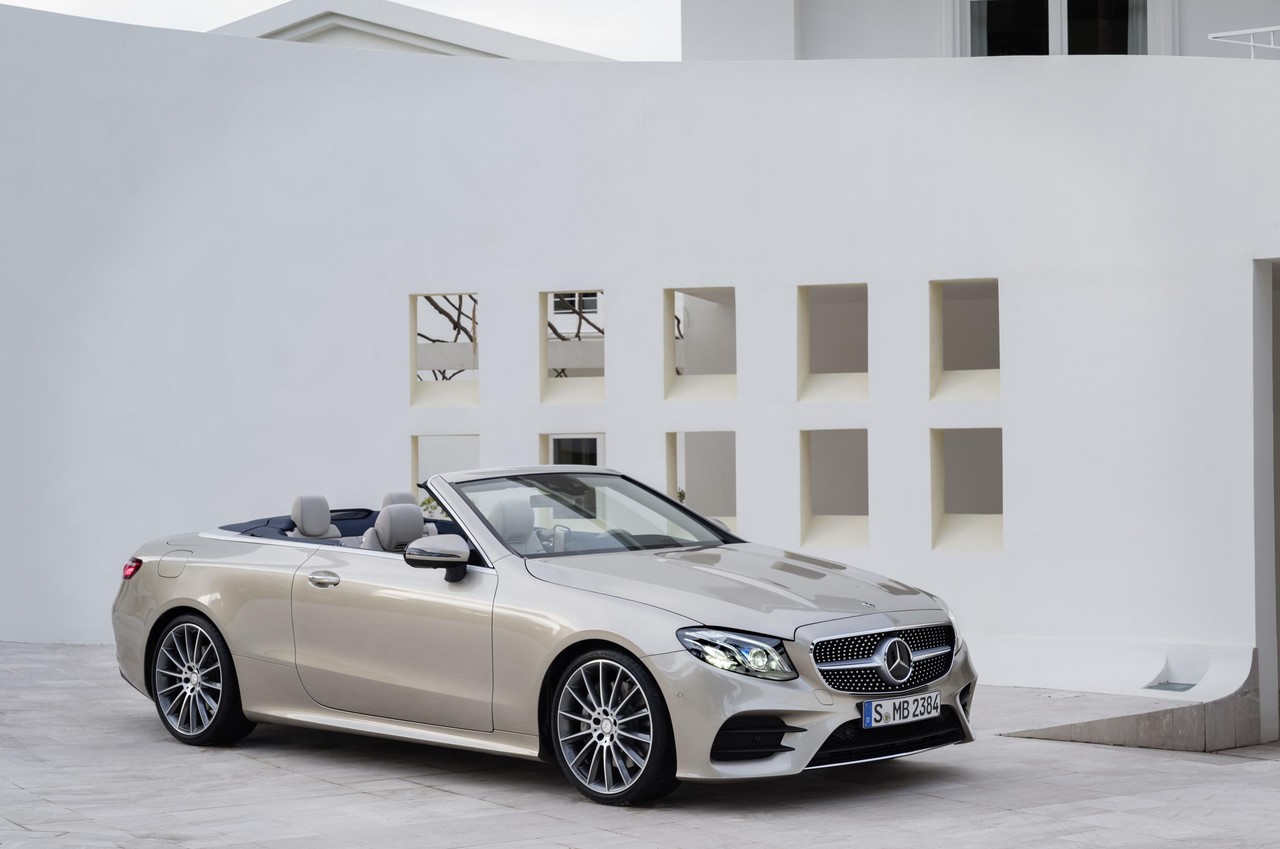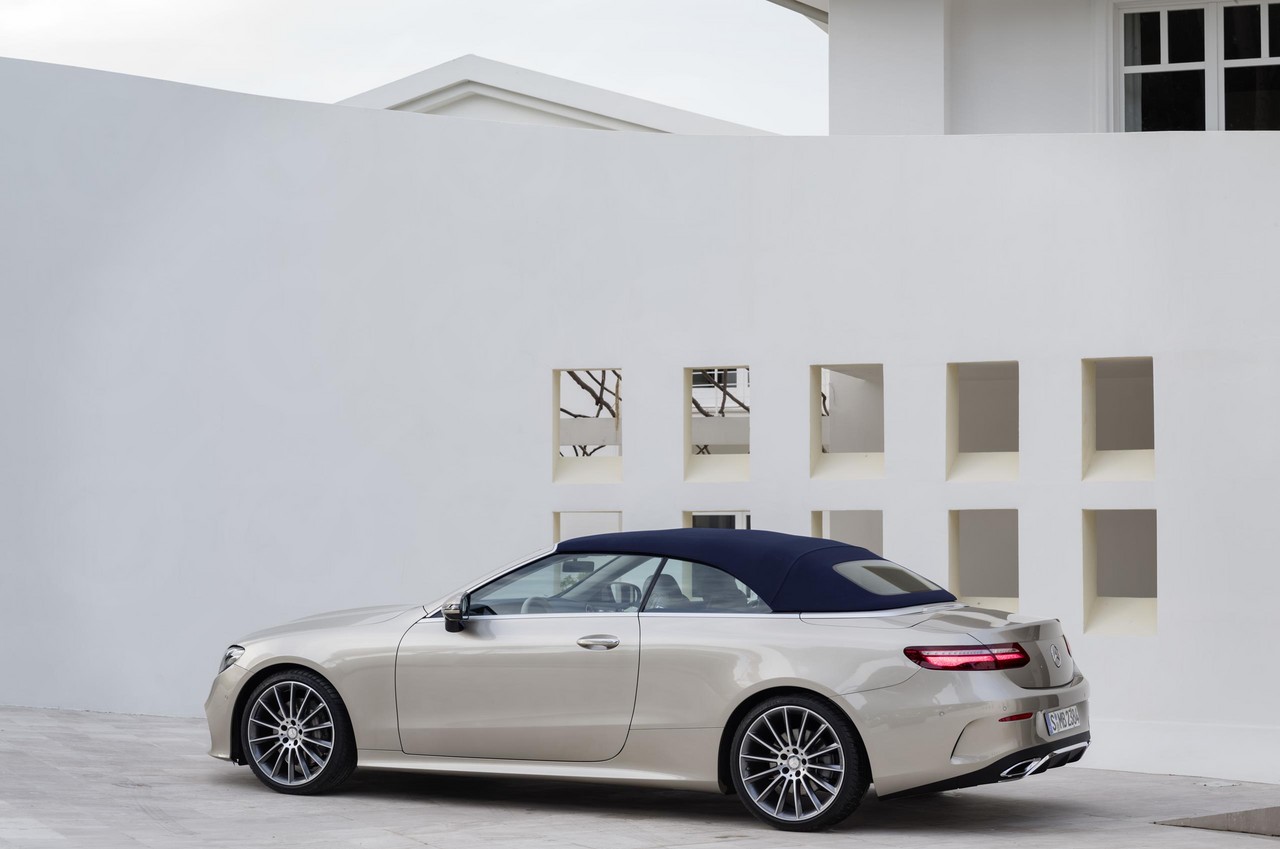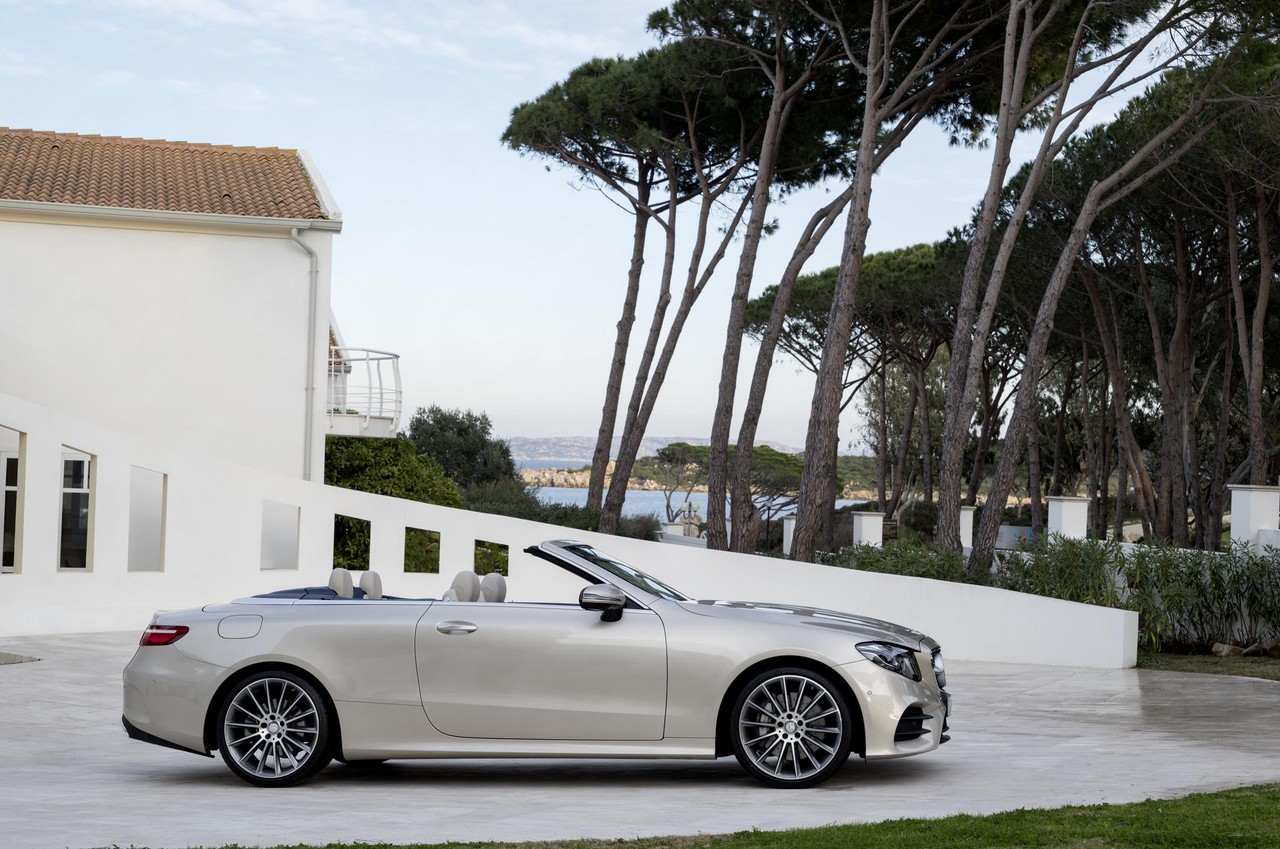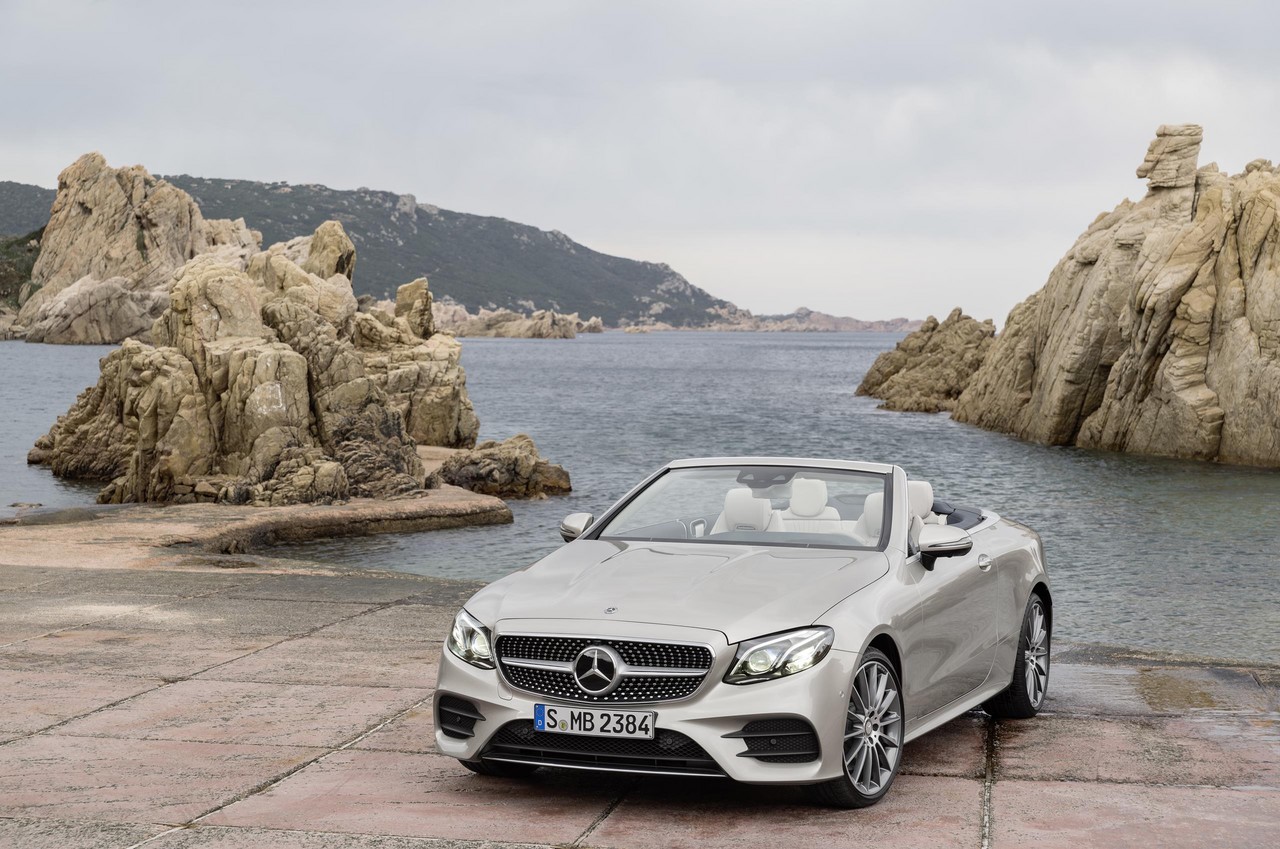
- High standard of interior fit and finish
- Quiet, well-insulated cabin
- Refined and responsive turbocharged six-cylinder engines
- Refined nine-speed automatic transmissions
- Active safety technologies
- Run-flat tyres hurt ride quality and compromise suspension tuning
- Steering lacks feel and feedback
- By class standards, good rear seat space (though, as always, limited headroom)
- Firm front seats
Overview
Production of the Mercedes-Benz A238 E-Class Cabriolet commenced in June 2017 and it was released in Australia in September 2017. Manufactured in Bremen, Germany, the Mercedes-Benz A238 E-Class Cabriolet was a four seat convertible with a soft-top roof. For Australia, the A238 E-Class Cabriolet range consisted of E 300 and E 400 4MATIC models (see table below), both of which had nine-speed automatic transmissions (Mercedes’ ‘9G-Tronic’) fitted as standard. The A238 E-Class Cabriolet was produced on the same production line as the C238 E-Class Coupe , C205 C-Class Coupe and A205 C-Class Cabriolet .
In September 2018, the A238 E-Class Cabriolet range was revised as the E 400 4MATIC was replaced by the E 450 4MATIC and the Mercedes-AMG A238 E 53 4MATIC+ was introduced.
| Engine | Trans. | Peak power | Peak torque | |
|---|---|---|---|---|
| E 300 (2017-23) |
1991 cc M274 turbo petrol I4 | 9sp auto | 180 kW at 5500 rpm | 370 Nm at 1400-4400 rpm |
| E 400 4MATIC (2017-18) |
2996 cc M276 biturbo petrol V6 | 9sp auto | 245 kW at 5250-6000 rpm | 480 Nm at 1600-4000 rpm |
| E450 4MATIC (2018-23) | 2996 cc M276 biturbo petrol I6 | 9sp auto | 270 kW at 5250-6000 rpm | 500 Nm at 1200-400 rpm |
| E 53 AMG 4MATIC+ (2018-23) |
2999 cc M256 biturbo petrol I6 | 9sp auto | 320 kW at 6100 rpm, plus 16 kW EQ Boost | 520 Nm at 1800-5800 rpm, plus 250 Nm EQ Boost |
Body and dimensions
The Mercedes-Benz A238 E-Class Cabriolet had a hybrid aluminium/steel body which combines aluminium, hot-formed steel parts and ultra-high strength steels; sheet aluminium was also used for the front wings, bonnet and boot lid to reduce mass. Beyond this, the roof was made from a combination of magnesium, extruded aluminium and steel (and eight kilograms lighter than a comparable all-steel structure). According to Mercedes, the standard acoustic fabric soft-top could open or close in twenty (20) seconds and be operated at speeds up to 50 km/h.
Compared to the Mercedes-Benz A207 E-Class Cabriolet which it replaced, the A238 E-Class Cabriolet was 123 mm longer (at 4826 mm), 74 mm wider (1860 mm), 20 mm taller (1428 mm) and had a 113 mm longer wheelbase (2873 mm); rear legroom also increased by 102 mm to 866 mm. The A238 E-Class Cabriolet had a boot capacity of 385 litres with the roof in its raised position, though this decreased to 310 litres when the roof was retracted. Furthermore, the A238 E-Class Cabriolet had a drag co-efficient of 0.29 Cd.
The Mercedes-Benz A238 E 300 Cabriolet had a kerb weight of 1780 kg, respectively.
Suspension
The Mercedes-Benz A238 E-Class Cabriolet had four-link front suspension and five-link rear suspension. The standard ‘Agility Control’ suspension had an amplitude-selective damping system which utilised:
- A bypass channel in each shock absorber’s piston pin; and,
- A control piston that moved within a separate oil chamber.
When linear travel of the shock absorber was low, the control piston forced oil through the bypass channel to produce a smaller damping force at the damper valve. For greater shock absorber movements, the control piston moved to close the bypass channel so full damping force was available. To be clear, Agility Control used hydromechanics, not electronics to vary suspension behaviour. Compared to the Mercedes-Benz W213 E-Class Sedan , the suspension for the E-Class Cabriolet is lowered by 15 mm.
As standard, the Mercedes-Benz A238 E 300 and E 400 4MATIC were fitted with ‘Air Body Control’ multi-chamber air suspension, which included roll/pitch/heave stabilisation. For the ‘Air Body Control’ suspension, three air chambers of different sizes in the spring struts of the rear axle and two air chambers in the spring struts of the front axle could vary the hardness of the suspension in three stages. The multi-chamber air suspension was also augmented by an electronically controlled adaptive damping system in which damping at each wheel was continually adjusted to road and driving conditions. From the Dynamic Select system, the driver could also select from Comfort, Eco, Sport, Sport+ and Individual settings.
Steering
The Mercedes-Benz A238 E-Class Cabriolet had rack-and-pinion steering with electric power assistance.
Safety equipment
Standard safety equipment for the Mercedes-Benz A238 E-Class Cabriolet included dual front airbags, a driver’s knee airbag, thorax/pelvis airbags for the front occupants, front and rear headbags (i.e. airbags integrated into the top edge of the front door panels), ABS, electronic brake force distribution, brake assist, electronic stability control, traction control, seatbelts pre-tensioners and load limiters for all seats and front seats with reversible belt tensioners.
For Australia, the Mercedes-Benz A238 E-Class Cabriolet was fitted with a ‘Driving Assistance package Plus’ which included:
- Drive Pilot: operated at speeds up to 210 km/h and could control the distance to the vehicle ahead, vehicle speed and steering via the following functions:
- Distance Pilot Distronic: adaptive cruise control that could maintain a safe distance from the vehicle ahead at speeds of up to 210 km/h and in stop/start traffic. An extended restart function also enabled automatic starting of the vehicle within 30 seconds after a stop that had been initiated by Distance Pilot Distronic;
- Steering Pilot: operating at speeds up to 130 km/h, Steering Pilot used a camera to detect road markings and vehicles ahead so that Steering Pilot could follow those vehicles even on roads with several lanes or unclear road markings. Steering Pilot could also provide steering assistance for ‘moderate bends’;
- Active Emergency Stop Assist: if the driver removed their hands from the steering wheel, warnings were issued to direct the driver to grip the steering wheel. If the driver did not respond, Active Emergency Stop Assist would bring the vehicle to a standstill within its lane. When vehicle speed was less than 60 km/h, the hazard lights would flash to warn following traffic;
- Active Lane Change Assist: a radar- and camera-based system which operated at speeds between 80 km/h and 180 km/h. Once the driver had indicated to turn for at least two seconds, Active Lane Change Assist would steer the vehicle into the adjacent lane if it detected that the lane is unoccupied;
- Active Brake Assist with cross-traffic function: operated at speeds from 7 km/h to 250 km/h and used information from radar sensors and a stereo camera to warn of imminent collisions – visually and audibly – with vehicles or pedestrians ahead of the vehicle and provide autonomous braking. Beyond this, the cross-traffic function could detect crossing traffic at junctions and, if the driver failed to respond, applied the brakes autonomously. Furthermore, it could detect hazardous situations at the tail-end of traffic jams (where there was no room to manoeuvre) and initiate autonomous braking far sooner than normal in such situations. Consequently, it was possible to avoid accidents at speeds up to 100 km/h or substantially reduce the severity of accidents at speeds up to 130 km/h;
- Evasive Steering Assist: complemented the pedestrian detection function of Active Brake Assist. When the driver deliberately or instinctively performed an evasive manoeuvre in a dangerous situation, Evasive Steering Assist would calculate the steering torque required to support the movement of the steering wheel – this helped the driver to avoid the pedestrian in a controlled manner and helped ‘straighten up’ the vehicle afterwards;
- Active Blind Spot Assist: At speeds above 12 km/h, Active Blind Spot Assist could warn of lateral collisions. At speeds above 30 km/h, a corrective braking force would be applied to the wheels on one side of the vehicle if the driver attempted to change lanes when a vehicle was detected in the driver’s blind spot;
- Active Lane Keeping Assist: initiated steering wheel vibrations if the vehicle approached a continuous lane marking line and, if crossed, automatically braked the wheels on one side of the vehicle to return the vehicle to its lane; and,
- Pre-Safe Plus: could anticipate rear-end collisions and warn following traffic by flashing the rear hazard warning lights at high frequency.
As standard, the Mercedes-Benz A238 E-Class Cabriolet was also equipped with –
- Roll-over protection: if a roll-over is imminent, two cartridges that were normally retracted behind the rear seats would be pyrotechnically fired to provide a survival space in combination with the A-pillar;
- Attention Assist with adjustable sensitivity: operated at speeds in excess of 80 km/h and monitored driver behaviour and steering movements for signs of drowsiness. If detected, the driver was provided with visual and audible warnings;
- Crosswind Assist: could detect sudden, strong gusts of wind and prevent the vehicle from drifting out of its lane via corrective braking forces on one side of the vehicle; and,
- An ‘active bonnet’ which, in the event of a pedestrian collision, triggered a pyrotechnic charge to raise the height of the bonnet and provide additional clearance to ‘hard points’ within the engine bay.
The Mercedes-Benz A238 E-Class Cabriolet was the first Mercedes-Benz vehicle to be equipped with ‘Pre-Safe Sound’. In the event of an anticipated collision, Pre-Safe Sound could triggers the stapedius reflex in the inner ear with a ‘short rushing sound’ from the sound system to prepare the inner ear for a loud impact noise and thereby reduce its harmful effects.
From September 2018, the Mercedes-Benz A238 E-Class Cabriolet was equipped with Traffic Sign Assist (TSA) which used navigation data and image recognition to display – in the instrument cluster – the maximum permitted speed, restrictions on overtaking and pedestrian warnings near ‘zebra’ crossings. Traffic Sign Assist also had an extended wrong-way warning, while the detection of stop signs was combined with the ECO start/stop function so that the engine remained on. Furthermore, Active Speed Limit Assist was a sub-function of Traffic Sign Assist that used the forward-facing camera to recognise sign gantries and road works signs to set the vehicle’s maximum speed.
Features: Mercedes-Benz A238 E 300 Cabriolet
For Australian deliveries, standard features for the Mercedes-Benz A238 E-Class Cabriolet included the COMAND Online Infotainment system which had a high-resolution display, digital radio tuner (DAB+), HDD navigation with 3D maps and dynamic route guidance, internet connectivity and smartphone integration via Android Auto or Apple CarPlay.
Beyond this, standard features for the Mercedes-Benz E 300 Cabriolet included 20-inch AMG multi-spoke alloy wheels with run-flat tyres, ‘Thermatic’ dual-zone climate control air conditioning, leather upholstery, power adjustable front sports seats with horizontal quilting, LED headlights with integral daytime running lights, dusk-sensing headlights, rain-sensing wipers, front and rear parking sensors, a Nappa leather steering wheel with gearshift paddles, 50:50 split-folding rear seat backrests, steering wheel gearshift paddles, remote central locking with proximity key, power adjustable and heated door mirrors with folding function, power windows, a power adjustable steering column (for height and reach), memory settings (for the front seats, steering wheel and door mirrors), an electrically-operated park brake, an automatically dimming rear-view mirror, push-button start, an analogue clock, a black roof liner, floor mats, synthetic leather (‘Artico’) dashboard trim, brushed stainless steel AMG sports pedals, black ash open-pore wood trim, ambient interior lighting, illuminated door sill panels, floor mats, a 12 volt power socket, a tyre pressure loss indicator, a trip computer and an immobiliser.
As standard, the A238 E-Class Cabriolet was also equipped with:
- Multi-beam LED headlamps: consisted 84 high-performance LED modules that were controlled by a high-resolution precision matrix module which had four control units to calculate the ideal light pattern 100 times per second. As such, the light distribution of the left and right headlamps could be adjusted separately, quickly and dynamically to suit changing conditions. Furthermore, the ‘cornering light’ function could be implemented without mechanical actuators;
- Adaptive Highbeam Assist Plus: active at speeds above 30 km/h, Adaptive Highbeam Assist Plus used a camera positioned behind the windscreen to detect vehicles ahead of the E-Class Cabriolet and oncoming traffic. Using this information, Adaptive Highbeam Assist Plus provided continuous, dazzle-free high beam lights and could use a mechanism in the headlamp module to mask a portion of the cone of light from the LED headlights;
- AirScarf neck-level heating: circulated warmed air around the head and neck areas of the occupants from the head restraints;
- AirCap wind protection system: consisted of an extendable wind deflector with a net that was set into the roof frame and an extendable draught-stop behind the rear seats;
- A 360 degree camera system which provided a bird’s eye view of the vehicle on the centre display and dynamic guidelines; and,
- Parking Pilot with Active Parking Assist: automatically engaged when driving at speeds up to 30 km/h, Parking Pilot could identify parallel and right angle parking spaces. Furthermore, the Parking Assist function cold provide automated steering to manoeuvre the vehicle into the space while the driver controlled vehicle speed.
Features: Mercedes-Benz A238 E 400 4MATIC Cabriolet
Compared to the A238 E 300 Cabriolet, the E 400 4MATIC Cabriolet was further equipped with a 590 watt Burmester surround sound system with thirteen speakers and a nine-channel digital sound processing (DSP) amplifier, and a head-up display.
Mercedes-AMG A238 E 53 4MATIC+ Cabriolet
Released in Australia in September 2018, the Mercedes-AMG E 53 4MATIC+ combined the M256 petrol engine with an ‘EQ Boost’ integrated starter/generator that produced 16 kW and 250 Nm. Using a 48 volt electrical system, EQ Boost could assist the petrol engine when accelerating and enabled the vehicle to coast or ‘sail’ without the operation of the petrol engine. The generator could also supply the battery with power through its energy recuperation function.
Standard features for Mercedes-AMG E 53 included 20-inch five twin-spoke alloy wheels, Burmester surround sound system, nappa leather upholstery, front sports seats, an acoustic soft-top, ‘Aircap’ automatic draught stop, ‘Airscarf’ neck-level heating for the front seats, AMG Performance exhaust system and AMG exterior styling (including a bootlip spoiler). The Mercedes-AMG E 53 also featured ‘Energizing Comfort Control’ which integrated various comfort systems in the vehicle – such as climate control, ambient lighting, massage and fragrancing functions – so that customers could configure settings for six program names: Freshness, Warmth, Vitality, Joy, Comfort and Training. For the complete list of features, please refer to the specifications document, below.
September 2018 update
From September 2018, Mercedes-Benz A238 E-Class Cabriolet models were fitted with new steering wheels that featured touch controls.
